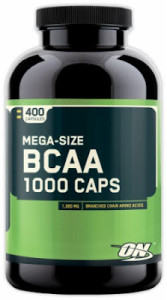Supplement Ingredient Guide: Branched Chain Amino Acids (BCAAs)

What is it?
BCAA’s are branched chain amino acids, more specifically they are:
- Isoleucine
- Leucine
- Valine
They cannot be derived naturally within the body, meaning that the only way the body can get hold of them is through diet and supplementation
Indications
It is indicated for those looking increase their lean mass, size and strength and improve recovery rate. All in all, one of the essential supplements any intermediate – advanced weightlifter should be on.
How much should I take?
Put easily you should be taking BCAA’s twice a day.
- 30 minutes before working out
- 30 minutes after working out
On none training days then:
- First thing in the morning
- Last thing at night before you go to bed
You should be taking 3-5 grams for each serving. Personally I stick 4 grams!
Research
Put simply, BCAAs are essential in the protein synthesis and muscle building process.
“In skeletal muscles and the heart, BCAA supplementation alone, has the same benefits of stimulating protein synthesis and reducing muscle breakdown, as is the case when the supply of all amino acids is increased (May and Buse, 1989). BCAAs supplementation has been demonstrated to preserve and even increase muscle size under extreme physical conditions where there would normally be a net loss of muscle tissue (Schena et al., 1992; Bigard et al., 1996). Research looking at the effect of BCAA supplementation during prolonged skiing at altitude, found that the consumption of BCAAs helped to prevent a loss of body mass (Bigard et al., 1996). Research has also demonstrated a positive effect on immune function with BCAAs supplementation (Bassit et al., 2000; Bassit et al., 2002).
During aerobic exercise, or any prolonged exercise session, BCAAs can be oxidized within the mitochondria of skeletal muscles to produce aerobic energy – the six other essential amino acids are mainly catabolized within the liver (Shimomura et al., 2004). It is well known that during aerobic exercise – endurance exercise in particular – the level of BCAAs metabolised to produce energy increases significantly (Rennie, 1996; Kobayashi et al., 1999). Therefore, during any prolonged period of exercise, a significant amount of BCAAs, may be metabolised and may lead to a depletion of BCAAs within muscles.
It should also be noted that Zinc, Magnesium, and Vitamin B6 all have positive effects on mood and may help to alleviate the low feeling sometimes experienced during heavy training.
Research looking at the effect of BCAA supplementation has found that taking 77mg of BCAAs, per kg of bodyweight, before exercise results in a significant reduction in the amount of muscle breakdown (MacLean et al., 1994). So to reduce muscle breakdown during exercise a 70kg athlete would consume around 5g of BCAAs. It has also been demonstrated that the consumption of BCAAs before and after exercise reduces the levels of serum creatine kinase activity – which indicates reduced levels of muscle breakdown (Coombes and McNaughton, 2000; Nosaka, 2003). BCAA supplementation before and after exercise also appears to increase the recovery rate from exercise, as indicated by a reduction in muscle soreness following exercise (Nosaka, 2003). Therefore, BCAA supplementation, before and after exercise, appears to be beneficial for reducing the level of exercise-induces muscle damage and for increasing muscle protein synthesis (muscle building) and enhancing the recovery process following exercise.
A further benefit, is the positive effects that BCAAs supplementation appears to have on endurance performance. BCAAs compete with the amino acid trytophan for uptake into the brain. During prolonged exercise BCAAs are used for fuel and this leads to a decreased level of BCAAs in the blood. The decreased levels of BCAAs in the blood means there is a greater ratio of tryptophan uptake into the brain. High levels of tryptophan in the brain, are associated with increased feelings of tiredness and fatigue, and hence, reduced exercise performance. Supplementation with BCAAs during exercise keeps the levels of BCAAs elevated in the blood and helps to delay the build up of tryptophan in the brain. Research suggests that supplementing with BCAAs during exercise may have a positive effect on exercise performance by reducing fatigue (Blomstrand et al., 1991).”13
Side effects
BCAAs have virtually no side effects!
Refernces
1- Bassit, R. A., Sawada, L. A., Bacurau, R. F. P., Navarro, F. and Costa Rosa, L. F. B. P. (2000) The effect of BCAA supplementation upon the immune system of triathletes. Medicine and Science in Sports and Exercise. 32, 1214-1219.
2- Bassit, R. A., Sawada, L. A., Bacurau, R. F., Navarro, F., Martins, E. Jr, Santos, R. V., Caperuto, E. C., Rogeri, P. and Costa Rosa, L. F. (2002) Branched-chain amino acid supplementation and the immune response of long-distance athletes. Nutrition. 18 (5), 376-379.
3- Bigard, A. X., Lavier, P., Ulmann, L., Legrand, H., Douce, P. and Guezennec, C. Y. (1996) Branched-chain amino acid supplementation during repeated prolonged skiing exercises at altitude. Int J Sport Nutr. 6 (3), 295-306.
4- Blomstrand, E., Hassmen, P. and Ekblom, B. (1991) Administration of branched-chain amino acids during sustained exercise-effects on performance and on plasma concentration of some amino acids. European Journal of Applied Physiology. 63, 83-88.
5- Coombes, J. S. and McNaughton, L. R. (2000) Effects of branched-chain amino acid supplementation on serum creatine kinase and lactate dehydrogenase after prolonged exercise. J Sports Med Phys Fitness. 40, 240-246.
6- Kobayashi, r. shimomura, Y., Murakami, T., Nakai, N., Otsuka, M., Arakawa, N., Shimizu, K. and Harris, R. A. (1999) Hepatic branched-chain alpha-keto acid dehydrogenase complex in female rats: activation by exercise and starvation. J Nutr Sci. Vitaminol. 45, 303-309.
7- May, M. E. and Buse, M. G. (1989) Effects of branched chain amino acids on protein turnover. Diab Metab Rev. 5 (3), 227-245.
8- MacLean, D. A., Graham, T. E. and Saltin, B. (1994) Branched-chain amino acids augment ammonia metabolism while attenuating protein breakdown during exercise. Am J Physiol. 267, E1010-E1022.
9- Nosaka, K. (2003) Muscle soreness and amino acids. Training J. 289, 24-28.
10- Rennie, M. J. (1996) Influence of exercise on protein and amino acid metabolism. In: Handbook of Physiology, Sect 12: Exercise: Regulation and Integration of Multiple Systems (Rowell, L. B. & Shepherd, J. T., eds), Chapter 22. 995-1035. American Physiological Society, Bethesda, MD.
11- Schena, F., Guerrini, F. and Tregnaghi, P. (1992) Branched-chain amino acid supplementation during trekking at altitude. The effects on loss of body mass, body composition, and muscle power. European Journal of Applied physiology. 65, 394-398.
12- Shimomura, Y., Murakami, T., Nakai, N., Nagasaki, M. and Harris, R. A. (2004) Exercise Promotes BCAA Catabolism: Effects of BCAA Supplementation on Skeletal Muscle during Exercise. J Nutr. 134, 1583S-1587S.
13- http://www.strengthandfitnessuk.com/branched-chain-amino-acids. Branched Chain Amino Acids (BCAAs). Accessed 03/08/2013
14- http://examine.com/supplements/Branched+Chain+Amino+Acids/#summary. Accessed 03/08/2013.
 Supplement Judge Unbiased Supplement Reviews – Do they really work??
Supplement Judge Unbiased Supplement Reviews – Do they really work??





[…] of supplements. The key items I’d recommend are whey protein, casein protein, multivitamin, BCAA, Waxy Maize Starch and creatine. For anyone looking to step it up a level higher I’d […]